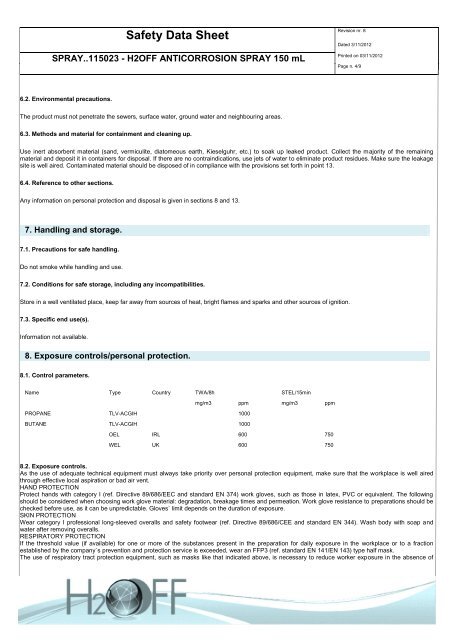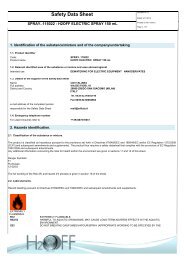SAFETY DATA SHEET Spray H2OFF Anticorrosion 210ml
SAFETY DATA SHEET Spray H2OFF Anticorrosion 210ml
SAFETY DATA SHEET Spray H2OFF Anticorrosion 210ml
You also want an ePaper? Increase the reach of your titles
YUMPU automatically turns print PDFs into web optimized ePapers that Google loves.
Safety Data Sheet<br />
SPRAY..115023 - <strong>H2OFF</strong> ANTICORROSION SPRAY 150 mL<br />
6.2. Environmental precautions.<br />
The product must not penetrate the sewers, surface water, ground water and neighbouring areas.<br />
6.3. Methods and material for containment and cleaning up.<br />
Revision nr. 8<br />
Dated 3/11/2012<br />
Printed on 03/11/2012<br />
Page n. 4/9<br />
Use inert absorbent material (sand, vermiculite, diatomeous earth, Kieselguhr, etc.) to soak up leaked product. Collect the majority of the remaining<br />
material and deposit it in containers for disposal. If there are no contraindications, use jets of water to eliminate product residues. Make sure the leakage<br />
site is well aired. Contaminated material should be disposed of in compliance with the provisions set forth in point 13.<br />
6.4. Reference to other sections.<br />
Any information on personal protection and disposal is given in sections 8 and 13.<br />
7. Handling and storage.<br />
7.1. Precautions for safe handling.<br />
Do not smoke while handling and use.<br />
7.2. Conditions for safe storage, including any incompatibilities.<br />
Store in a well ventilated place, keep far away from sources of heat, bright flames and sparks and other sources of ignition.<br />
7.3. Specific end use(s).<br />
Information not available.<br />
8. Exposure controls/personal protection.<br />
8.1. Control parameters.<br />
Name Type Country TWA/8h STEL/15min<br />
PROPANE TLV-ACGIH 1000<br />
BUTANE TLV-ACGIH 1000<br />
mg/m3 ppm mg/m3 ppm<br />
OEL IRL 600 750<br />
WEL UK 600 750<br />
8.2. Exposure controls.<br />
As the use of adequate technical equipment must always take priority over personal protection equipment, make sure that the workplace is well aired<br />
through effective local aspiration or bad air vent.<br />
HAND PROTECTION<br />
Protect hands with category I (ref. Directive 89/686/EEC and standard EN 374) work gloves, such as those in latex, PVC or equivalent. The following<br />
should be considered when choosing work glove material: degradation, breakage times and permeation. Work glove resistance to preparations should be<br />
checked before use, as it can be unpredictable. Gloves` limit depends on the duration of exposure.<br />
SKIN PROTECTION<br />
Wear category I professional long-sleeved overalls and safety footwear (ref. Directive 89/686/CEE and standard EN 344). Wash body with soap and<br />
water after removing overalls.<br />
RESPIRATORY PROTECTION<br />
If the threshold value (if available) for one or more of the substances present in the preparation for daily exposure in the workplace or to a fraction<br />
established by the company`s prevention and protection service is exceeded, wear an FFP3 (ref. standard ΕΝ 141/EN 143) type half mask.<br />
The use of respiratory tract protection equipment, such as masks like that indicated above, is necessary to reduce worker exposure in the absence of



